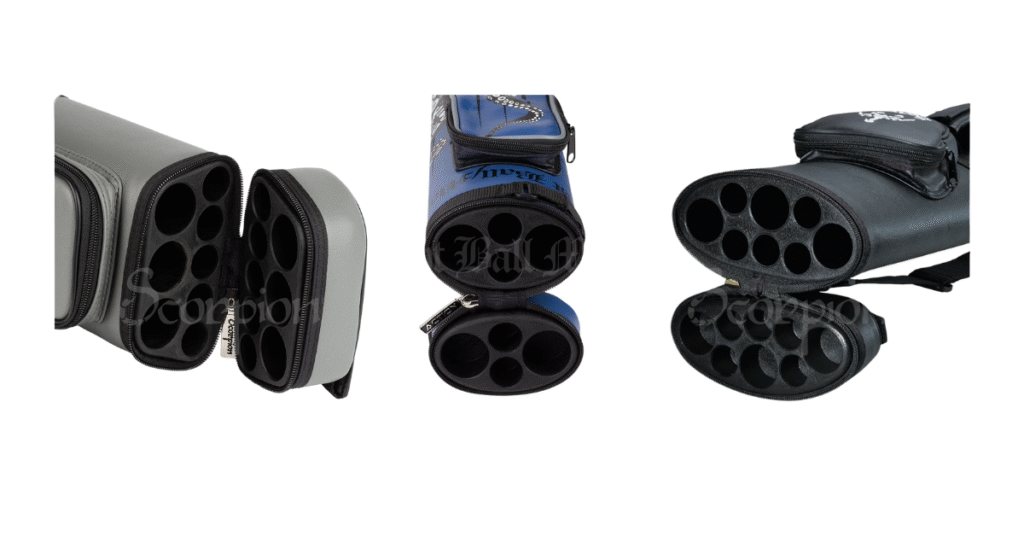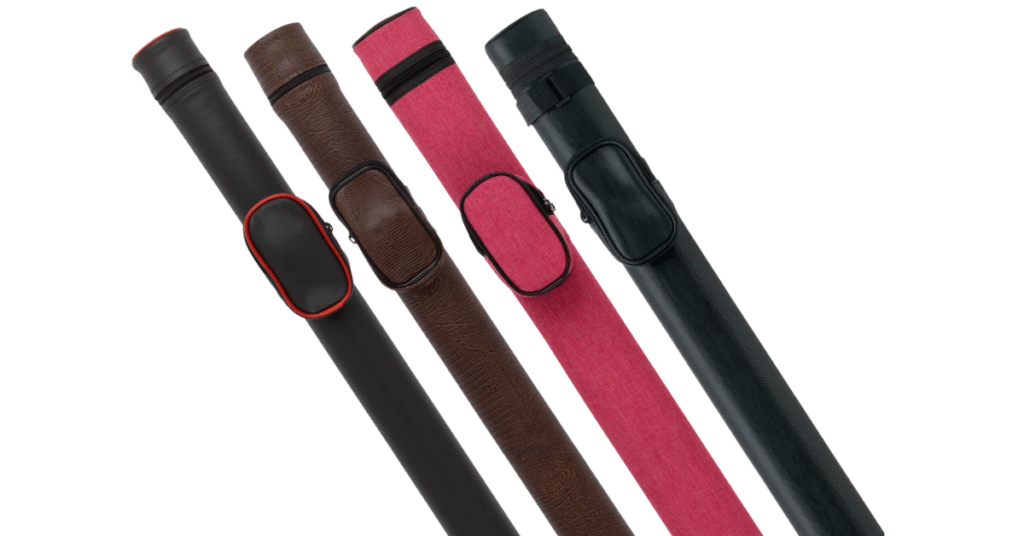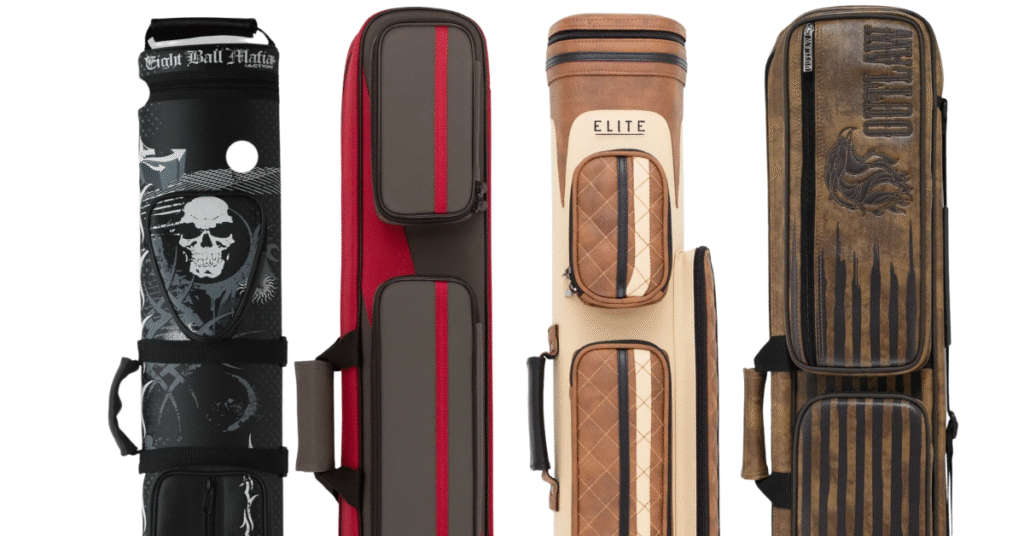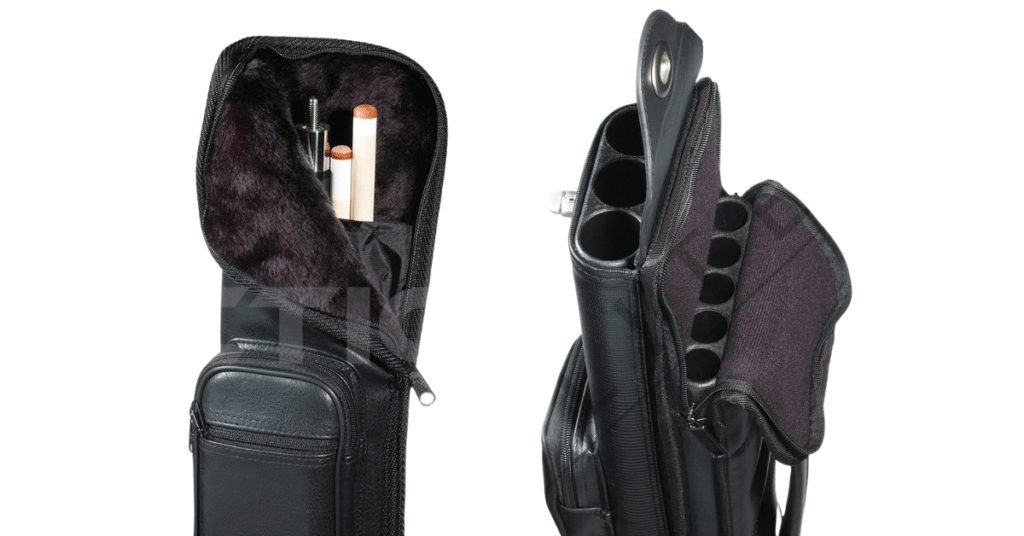Buying Guides
How to Choose the Right Pool Cue Case Size
When most players start investing in their game, they usually think about the cue first. That makes sense. The cue is what connects you to the table. But there is another piece of gear that deserves just as much attention: the cue case.
A cue case is not only about storage. It protects your cue from heat, moisture, scratches, and the accidental bumps that happen when you travel from home to the pool hall. Choosing the right size makes all the difference between playing smoothly and worrying about your gear.
This guide will help you understand how cue case sizing works, what fits different types of players, and how to make a smart choice that lasts.
Understanding Cue Case Sizes

| Case Size | Number of Butts | Number of Shafts | Total Cue Setups |
|---|---|---|---|
| 1×1 | 1 | 1 | 1 full cue |
| 1×2 | 1 | 2 | 1 cue with spare shaft |
| 2×2 | 2 | 2 | 2 full cues |
| 2×4 | 2 | 4 | 2 full cues with spare shafts |
| 3×5 | 3 | 5 | 3 cues with extras |
| 4×8 | 4 | 8 | 4 cues with spare shafts |
Every cue case is labeled with a set of numbers like 1×1, 2×2, or 2×4. These numbers tell you how many butts and shafts the case can hold. The first number is the number of butts, and the second is the number of shafts.
A 1×1 case holds one complete cue. A 2×2 case holds two cues. A 2×4 case can fit two butts and four shafts. Some professional cases go up to 3×5 or even 4×8, made for players who carry multiple cues for breaks, jumps, and playing.
For new or casual players, these numbers can sound like overkill. You might think that having a big case means you are better prepared. But a bigger case is not always better. It depends on how you play and how much gear you really use.
Why Does Each Cue Case Have a Set Capacity? Can I Just Fit Them All In One Slot?
At first, it might seem easier to have one large compartment and throw in all your cues together. In reality, that design would damage your cues fast.
Each cue case is divided into fixed tubes for a reason. The main goal is protection. A cue is delicate. Even a small bump can bend or chip the wood. If cues share the same space, they will hit each other whenever you move. That means scratches, dents, or warped shafts in no time.
The second reason is stability. Separate tubes keep the weight balanced and prevent pressure on the cue joints. A single open compartment would shift the weight unevenly and make the case bend or twist over time.
Finally, there is convenience. When every cue has its own slot, you can grab what you need right away. No searching, no shaking the case, no risk of pulling out the wrong part.
So the structured layout is not just about looks. It is about keeping your cues straight, safe, and ready to play for years.
Small and Compact Cases

If you usually play on weekends or drop by a bar to shoot a few racks, a compact case is all you need. A 1×1 or 1×2 case keeps things simple. It is light, easy to carry, and protects your cue just as well as any larger model.
Small cases are also ideal if you walk or ride a motorbike to your local pool room. They take up less space, fit easily in lockers, and never feel bulky.
The main downside is capacity. You will not have room for a backup shaft or a jump cue. But if you are not playing in tournaments, you probably will not need them.
The goal is to have something that feels comfortable and easy to manage. For most recreational players, a compact case checks all the boxes.
Medium Size Cases

As you get more serious about your game, you might start to see the value of having an extra shaft or a different tip for certain shots. Maybe you have a jump cue or a break cue that you like to keep handy.
This is where a medium size case, like a 2×2 or 2×4, makes sense. These cases give you more flexibility without becoming heavy or oversized. You can pack your main cue, an extra shaft, and still have space for chalk, gloves, or a small towel.
A 2×2 case is a perfect middle ground. It can grow with you as your skills improve. You do not have to buy another case soon, and you can start building your gear set gradually.
A 2×4 case gives even more breathing room. Many serious hobbyists and semi-pro players stick with this size because it balances storage, protection, and mobility. You can take it anywhere without feeling weighed down.
Large Tournament Cases

Players who compete often or travel to events tend to carry more gear. They may use different shafts for breaking, jumping, or specific table conditions. In that case, a larger case becomes necessary.
Cases like 3×5 or 4×8 are designed for heavy use. They usually include thick padding, reinforced shells, and multiple compartments for tools, accessories, and maintenance kits.
The tradeoff is weight. These cases are not meant for casual sessions or quick visits to the local pool hall. They are for players who treat pool as a sport and travel regularly.
If that sounds like your lifestyle, a bigger case is a smart investment. It keeps all your equipment together and ready for any situation.
What Really Matters Beyond Size

While capacity is important, it is not the only factor to consider. The right cue case should feel right in your hand and on your shoulder. Pay attention to how the handle sits, how the strap fits across your body, and how easy it is to open or close.
Look for solid padding that absorbs impact. Hard cases protect better when you travel by car or plane. Soft cases are lighter and easier to carry around town. Some players prefer hybrid models that blend the two.
Material also matters. Leather and high-grade vinyl are popular because they resist scratches and hold up under daily use. Nylon and canvas offer lighter options that still provide good protection for casual players.
You should also think about storage compartments. Having a few pockets for chalk, gloves, and a tip tool is convenient. But too many compartments can make a case bulky and hard to manage. Keep it simple.
Read More: Hard vs Soft Pool Cue Cases: Which One Protects Better?
Matching Your Case to Your Playing Style

If you play occasionally and just need something to protect your cue, a small case is perfect. It keeps your gear safe and easy to handle.
If you play a few times a week and like having a spare shaft or a jump cue, a medium size case like a 2×2 or 2×4 is ideal. It fits most setups and still feels light enough to carry anywhere.
If you compete or travel frequently, you will benefit from a larger case. It helps you organize all your cues, shafts, and tools so that you can focus on your game instead of your gear.
Think about your habits. How often do you play? How far do you travel? How much equipment do you actually use? The answers will guide your choice naturally.
Comfort and Practicality

Many players overlook comfort until they carry their case for an hour. A comfortable shoulder strap or balanced handle makes a big difference. You want the weight to feel even and the case to stay stable as you walk.
Also, make sure the case opens and closes smoothly. A tight or tricky latch might sound like a small issue, but it becomes annoying fast. Quality zippers or magnetic closures save you time and effort.
Another key factor is how the cues fit inside. The shafts and butts should slide in without friction but also stay secure when the case is upright or tilted. Loose fittings can cause movement that leads to damage.
If you can, test the case before buying. Feel the texture, check the stitching, and try loading your cue in and out. The best case is the one that feels natural in your hands.
Durability and Long-Term Value

A good cue case should last for years. Even if you start small, it pays to choose one that is well built. Look for thick lining, clean seams, and sturdy hardware. These details often separate budget cases from quality ones.
Spending a bit more upfront saves money later. A durable case keeps your cue safe from dents, warping, or moisture. It also holds its shape and looks good even after regular use.
For players who see pool as a long-term passion, investing in a solid case is a simple but wise move. It protects your cue, and it shows that you take your game seriously.
A Choice That Works for Everyone
If you are unsure which way to go, a 2×2 or 2×4 cue case is the safest and smartest option. It has enough space for your main cue and a backup shaft. It fits the needs of beginners, casual players, and advanced players alike.
This size offers flexibility as your game evolves. You can start with one cue and later add more without needing a new case. It is portable, protective, and practical in nearly every situation.
A 2×2 or 2×4 case gives you room to grow while keeping your setup clean and organized. It is the balanced middle ground between minimalism and full competition gear.
Final Thoughts
Choosing the right pool cue case size is not about showing off or collecting equipment. It is about matching your gear to your real habits. A case that fits your routine will make every trip to the table easier and more enjoyable.
If you are just starting out, go simple. If you play regularly, give yourself a bit more space. If you compete, choose something built to handle the road.
But if you want one clear choice that works for almost everyone, go with a 2×2 or 2×4 case. It covers all bases, keeps your cue protected, and stays by your side as your game grows.
That balance is what makes the difference between just owning gear and truly owning your game.

